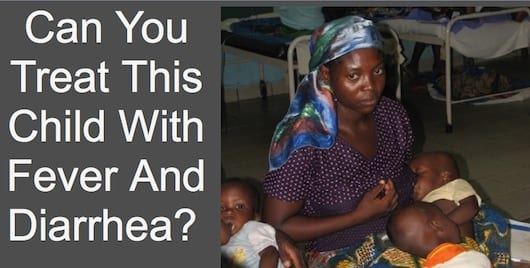With eagerness and a dose of trepidation you step into a new clinical setting. On your far left a Somali woman is delivering twins with the aid of two students and a supervisor. On your right a young Asian man gasps for breathe as a resident physician and a faculty examine him. In the back of the room three interns and their attending are triaging injured Hispanics newly arrived from a building collapse. Where in one place could you find such a fascinating spectrum of healthcare? Only the Tropical Medicine Rounds Simulation at the upcoming Exploring Medical Missions Conference – the EMMC.
You are beckoned to the room’s center where you interview an African mother and her eighteen-month old daughter, Rosa. The mother explains that Rosa is losing weight, eating poorly and having diarrheal stools for weeks. The family’s water source is a creek. You examine the child, who is somnolent, with an oral temperature of 38 degrees C, respirations of 30, and abdomen distended but without guarding. You consider whether Rose be could suffering from typhoid fever. Which ONE of these statements about typhoid is true?
A. Typhoid fever usually causes diarrhea.
B. Salmonella typhi is transmitted by fecal-oral ingestion
C. Typhoid vaccination is reliably effective.
D. Typhoid fever can be readily differentiated from other infectious diseases
Answer
You consult with your appointed supervisor and learn that typhoid fever does not frequently cause diarrhea, but shares many of the risk factors associated with other fecal-oral transmitted diseases. Typhoid should be considered in persons with persistent, unexplained fever and abdominal pain. Diagnosis is often challenging, for the differential diagnosis may readily includes malaria, viral hepatitis, enteric fever syndromes, atypical pneumonia, mononucleosis, tuberculosis, and brucellosis. Typhoid vaccination effectiveness is only about seventy-five percent. “B” you conclude is the correct answer.
You ponder the next step in caring for Rosa. Which of the following will be your highest priority?
A. Establishment of intravenous access
B. Initiation of ciprofloxacin antibiotic therapy
C. Collection of a stool specimen and laboratory analysis
D. Provision of oral rehydration therapy
Answer
Ciprofloxacin, amoxicillin, and trimethoprim-sulfamethoxazole are antibiotics commonly overused to treat diarrhea, which is more often viral in etiology. Examination of fresh stool under a microscope revealing blood and fecal leukocytes suggest invasive bacterial causes like Shigella and Campylobacter, while their absence points toward viral and enterotoxigenic causes. Ova, and less commonly parasites, may be identified. Most diarrheal disease can most successfully treated with oral rehydration solution, consisting simply of potable water, salt and sugar. “D” you surmise to be the best answer.
Assisting people in a new, cross-cultural, low-resource setting is for healthcare professionals and students one of the most daunting challenges imaginable, and one rarely addressed in our formal training. We invite you to take advantage of unique learning opportunities like the Tropical Medicine Simulation Rounds at the Exploring Medical Missions Conference.

